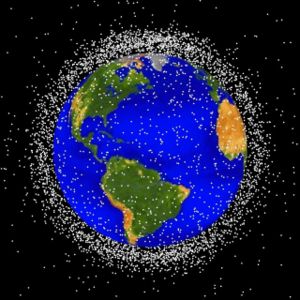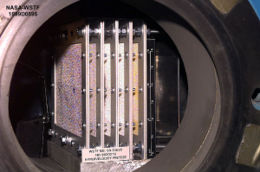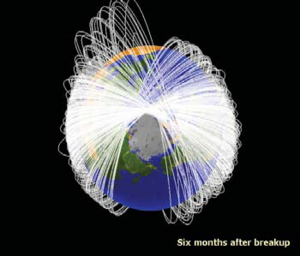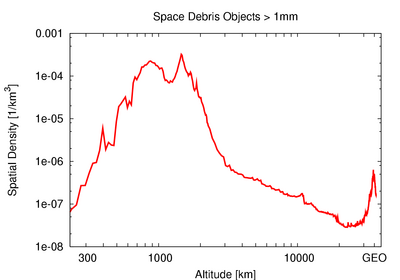Space debris
Space debris, also called orbital debris, space junk and space waste are man-made objects in earth orbit that no longer serve any useful purpose. They include defunct satellites, spent rocket stages, rocket slag, coolant droplets, paint flakes, and other objects. [1]
Space debris is a risk to both manned and unmanned spaceflight programs. Objects in orbit travel at very high velocities, and release large amounts of energy when they collide. Large debris (1 cm or more) can severely damage or destroy a satellite or other spacecraft on impact.
History and creation of space debris

The history of space debris very closely follows the history of human spaceflight. The oldest piece of debris still in orbit is Vanguard 1, which was launched in 1958. The satellite functioned from March through June of that year before ceasing useful operation, but it is likely to remain in orbit for 200 more years before finally re-entering the atmosphere. Since then hundreds of artificial satellites have been launched into orbit, and many of them remain even after their usefulness has ended.
Defunct satellites aren't the only pieces of debris in orbit, however. Spacecraft from Earth are almost always launched on multiple-stage rockets, and the upper stages of these rockets usually separate from the payload after they have already achieved low Earth orbit (LEO). Vehicles also commonly produce other debris during the deployment phase, including explosive bolts and other components only needed during the launch phase. All of these can remain in orbit, contributing to the debris population.
One of the biggest source of dangerous space debris is explosions. Upper stages of rockets typically contain leftover fuel, and electric shorts or impacts can cause these to explode, creating more debris fragments. About 100 tons of fragments generated during approximately 200 such events are still in orbit.
Manned spaceflight is a source of some unique pieces of debris. Astronauts sometimes lose objects during spacewalks, and these have included a glove lost by astronaut Ed White on the first American space-walk, a camera Michael Collins lost near the spacecraft Gemini 10, garbage bags, a wrench and a toothbrush.[2] Sunita Williams of STS-116 also lost a camera during an EVA. Most of those unusual objects have re-entered the atmosphere of the Earth within weeks due to the orbits where they were released and their small sizes. Things like these are not major contributors to the space debris environment. Cosmonauts on Russian space stations even disposed of their garbage by ejecting it into space before the problems posed by space debris were realized.
Another unique source of debris was Project West Ford, two tests carried out by Massachusetts Institute of Technology's Lincoln Laboratory on behalf of the United States military. They sought to create a ring of copper dipole antennas (2cm long needles) in orbit which would allow global radio communication. After a failed first attempt in 1961 (the needles failed to disperse), the project was eventually successful with the 1963 launch, with radio transmissions carried by the man-made ring. However, the technology was ultimately shelved, partially due to the development of the modern communications satellite and partially due to protests from other scientists.[3] The needles were placed in orbits between 3500 and 3800 km high at 96 and 87 degree inclinations and contributed to Earth's orbital debris.[4] As of 2006 several clumps of the needles are still in orbit[5][6], and occasionally reentering.[7]
The largest space debris creation incident was the Chinese anti-satellite weapon (ASAT) test on January 11, 2007.[8] The event created more than 1900 pieces of trackable debris, 35,000 pieces larger than 1 cm across, and over 1 million pieces larger than 1 mm across. These debris are in a high orbital plane and likely won't decay for at least 35 years. In June, 2007, NASA's Terra environmental spacecraft was the first to be moved in order to prevent impacts.[9]
Dangers of space debris
Space debris pose a significant problem to both manned and unmanned spacecraft. Objects in orbit around earth travel at very high speeds, and typically collide at relative velocities around 10 kilometers per second. At these speeds even small objects impact with great energy.
Objects of different sizes set up different challenges for mission planners. Large objects, about 10 cm or larger in diameter, have the greatest potential to cause damage to spacecraft, but are also big enough to be easily tracked and are therefore easier to avoid. Very small objects, less than 1 cm in size, cause the least damage individually, but are also by far the most common particles, as they are virtually omnipresent in low-Earth orbits. The biggest danger they present is in causing erosive damage, somewhat like a sandblaster.
The Kessler Syndrome is a scenario, proposed by NASA consultant Donald J. Kessler, in which the quantity of space debris in orbit is so high that it prevents economic spaceflight in or through low-Earth orbit. Although the current debris field isn't nearly so dense, scientists speculate that a large explosion could trigger an ablation cascade in which large debris continually collide with more large satellites, creating even more debris.[10]
Mitigation

In order to mitigate the generation of additional space debris, a number of measures have been proposed: The passivation of spent upper stages by the release of residual fuels is aimed at decreasing the risk of on-orbit explosions that could generate thousands of additional debris objects.
Taking satellites out of orbit at the end of their operational life would also be an effective mitigation measure. This could be facilitated with a "terminator tether," an electrodynamic tether that is rolled out, and slows down the spacecraft.[11] In cases when a direct (and controlled) de-orbit would require too much fuel the satellite can also be brought to an orbit where atmospheric drag would cause it to de-orbit after some years. Such a maneuver was successfully performed with the French Spot-1 satellite at the end of 2003. It will re-enter in approximately 15 years.
In orbital altitudes where it would not be economically feasible to de-orbit a satellite, like in the geostationary ring they are brought to a graveyard orbit where no operational satellites are present.
Proposals have been made for ways to "sweep" space debris back into Earth's atmosphere, including automated tugs, laser brooms to vaporize or nudge particles into rapidly-decaying orbits, or huge aerogel blobs to absorb impacting junk and eventually fall out of orbit with them trapped inside. However, currently most effort is being devoted to prevention of collisions by keeping track of larger debris, and prevention of more debris.
Other ideas include the gathering of larger objects into an orbital "junk yard", where they could be used as resources should future needs arise, while keeping them out of the way.
Some spacecraft, like the International Space Station, are now armored to mitigate damage with this hazard. Astronauts on EVAs are also vulnerable.
Cleanup
For very small fragments, no known technology can collect and deal with the many fragments from the widely separated orbital planes.
One technology for the bigger fragments that can be tracked is the laser broom, a multimegawatt land-based laser that could be used to target fragments. When the laser light hits a fragment, one side of the fragment would ablate, creating a thrust that would change the eccentricity of the remains of the fragment until it would re-enter harmlessly.[12]
Monitoring
Because the most useful satellite orbits are in low-earth orbit and geostationary orbit these regions of space have the greatest concentration of debris.
The U.S. Strategic Command maintains a catalog containing about 10,000 orbital objects in order to avoid false-positives when scanning for missiles. Observation data gathered by a number of ground based radar facilities and telescopes as well as by a space based telescope[13] are used to maintain this catalog. Nevertheless, the vast majority of debris remain unobserved. There are more than 600,000 objects larger than 1 cm in orbit (according to the ESA Meteoroid and Space Debris Terrestrial Environment Reference, the MASTER-2005 model).
Other sources of knowledge on the actual space debris environment include measurement campaigns by the ESA Space Debris Telescope, TIRA[14], Goldstone radar, Haystack radar,[15] and the Cobra Dane phased array radar.[16] The data gathered during these campaigns is used to validate models of the debris environment like ESA-MASTER. Such models are the only means of assessing the impact risk caused by space debris as only larger objects can be regularly tracked.
Returned space debris hardware is also a valuable source of information on the (submillimetre) space debris environment. The LDEF satellite deployed by STS-41-C Challenger and retrieved by STS-32 Columbia spent 68 months in orbit. The close examination of its surfaces allowed the analysis of the directional distribution and the composition of debris flux. The EURECA satellite deployed by STS-46 Atlantis in 1992 and retrieved by STS-57 Endeavour in 1993 could provide additional insight.
The solar arrays of the Hubble Space Telescope returned during missions STS-61 Endeavour and STS-109 Columbia are an important source of information on the debris environment. The impact craters found on the surface were counted and classified by ESA to provide another means for validating debris environment models.
References
- ↑ Technical report on space debris (PDF). United Nations (1999). Retrieved on 2006-04-05. ISBN 92-1-100813-1
- ↑ Tufte, Edward. Envisioning Information.
- ↑ Kendall, Anthony (May 2, 2006). Earth's Artificial Ring: Project West Ford. DamnInteresting.com. Retrieved on October 16, 2006.
- ↑ Position Paper on Space Debris Mitigation - Implementing Zero Debris Creation Zones (PDF). International Academy of Astronautics (05). Retrieved on 2007-20-08.
- ↑ Westford dipoles aoe.vt.edu, (note error in 8MHz->8 GHz), 2003-09-18
- ↑ deb West Ford - Orbit Data showing orbit and ephemeris for epoch October 15, 2006, heavensabove
- ↑ RAE Table of Earth Satellites (MS Word doc) 2000, Extra-page-1 to Extra-page-4, "148 pieces, 92 have decayed"
- ↑ Chinese ASAT Test. Retrieved on 2007-07-04.
- ↑ Burger, Brian. NASA's Terra Satellite Moved to Avoid Chinese ASAT Debris. Retrieved on 2007-07-06.
- ↑ D.J. Kessler (1991). "Collisional Cascading: The Limits of Population Growth in Low Earth Orbit". Advances in Space Research 11: 63.
- ↑ Christensen, Bill. The Terminator Tether Aims to Clean Up Low Earth Orbit. Retrieved on 2006-03-08.
- ↑ SpaceDaily- NASA Hopes Laser Broom Will Help Clean Up Space Debris
- ↑ The Space-Based Visible Program. MIT Lincoln Laboratory. Retrieved on 2006-03-08.
- ↑ Klinkrad, H.. Monitoring Space – Efforts Made by European Countries (PDF). Retrieved on 2006-03-08.
- ↑ MIT Haystack Observatory. Retrieved on 2006-03-08.
- ↑ AN/FPS-108 COBRA DANE. Retrieved on 2006-03-08.

